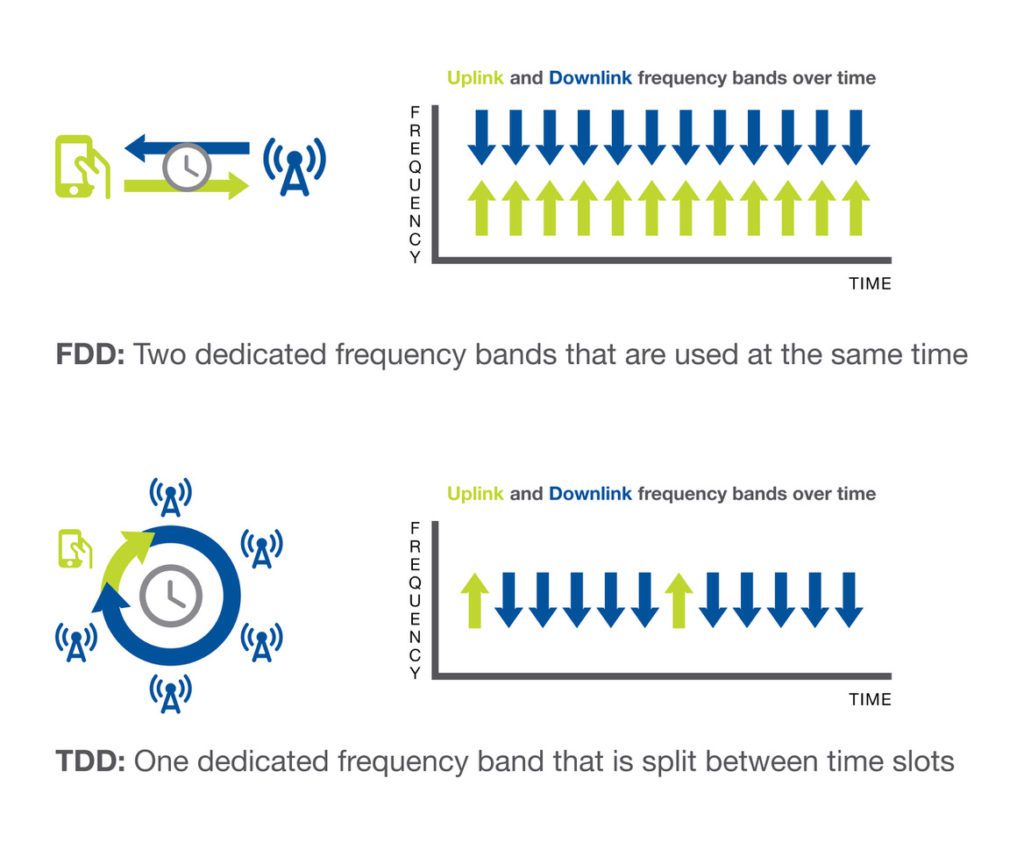
The ever-growing demand for mobile connectivity is driving a transformation in wireless technology. Without a doubt, the most significant shift happening right now is the adoption of 5G. Next-generation 5G technology allows enhanced mobile broadband (eMBB) to deliver faster speeds across a wide coverage area, opening the door to a wide array of innovative and profitable new use cases — from automated factories and autonomous vehicles, to smart homes and cities.
Many of the new applications that 5G technology enables rely on more stringent performance and lower latency than previous mobile generations were capable of delivering. Achieving these technical requirements, however, requires a fundamental change in how the network uses radio frequency (RF) spectrum. Evolution to 5G introduces new, larger spectrum bands that exclusively use Time Division Duplexing (TDD), versus the Frequency Division Duplex (FDD) timing sequence that legacy mobile communications technologies employ.
Additionally, network operators are building out more dense cell sites in order to deliver sufficient coverage, capacity, speed, and performance in 5G, making it crucial that all the radio access network (RAN) elements and user devices are seamlessly synchronized with each other. Furthermore, 5G also takes advantage of advanced RF optimization technologies, such as massive MIMO, dynamic spectrum sharing (DSS), beamforming, and carrier aggregation, which require accurate timing for proper operation.
Taken together all of these technical complexities contribute to a critical need for precise timing and synchronization in 5G networks.
Timing is Everything
A key difference with TDD spectrum usage is that both the uplink (UL) and downlink (DL) signals are transmitted on the same frequencies, as opposed to the FDD method that uses separate, paired frequency blocks to transmit and receive traffic. 5G technology relies on TDD bands to provide support for larger channel bandwidth and asymmetrical UL / DL channels to make more efficient use of valuable 5G spectrum.
Yet, with both uplink and downlink data transmissions on the same frequency, there is a much greater chance of interference, with any lack of synchronization between UL / DL frames making matters worse. That means that exact time and phase alignment between base stations is required in order to prevent signal interference and dropped calls with TDD. In fact, 5G new radio (NR) specifications introduce very stringent restrictions on TDD transmissions, with an absolute time synchronization margin of just 1.5µs, compared to a margin of 10µs in the previous FDD LTE environment.
These requirements are particularly important when accommodating new use cases. While many service providers typically follow a standard 80/20 rule for downloading and uploading content, this network parameter is likely to cause congestion as traffic patterns change, increasing the odds of interference. For example, faster 5G speeds are expected to continue driving more uplink traffic, such as cloud storage, or the practice of uploading selfie photos and videos in crowded entertainment venues.
To accommodate the need for precise synchronization with TDD, 5G networks use a highly accurate timing sequence called the Precision Time Protocol (PTP) that shares the same time reference from end to end throughout the network. The PTP function maintains time, phase, and frequency synchronization from the network core to the edge of the service provider’s network. This helps to ensure good quality of experience (QoE) for subscribers using the outdoor macro network.
Get in Sync
But what about service indoors where roughly 80 percent of all mobile voice and data traffic occurs? For those commercial buildings, multi-dwelling units (MDUs), and enterprise offices with a distributed antenna system (DAS) deployed in-building, the PTP assurance of 5G timing and synchronization ends where the DAS begins. To provide reliable 5G service and ensure QoE for indoor subscribers, in-building DAS infrastructure needs to support the timing sequence of TDD.
With the SOLiD ALLIANCE DAS platform 2W, 5W, 20W and Multi-Power Remote Optical Unit, synchronization occurs at the remote unit on the edge of the network, not at the system headend. Likewise, the edgeROU fiber-to-the-edge remotes synch at the edgeHUB typically located in the independent distribution frame (IDF) closet on each floor.
By synching closer to the mobile device, our system provides improved timing and synchronization for seamless connectivity, reducing dropped calls and interference in-building. Additionally, if a sync detection module should fail, the area of impacted coverage is minimized. Alternatively, other systems that sync at the headend can suffer from an extra delay caused by the distance from where they sync to user devices, as well as being vulnerable to total outages, resulting in a poor subscriber experience.
The SOLiD DAS platform not only matches exacting timing and synchronization to improve service quality — similarly to how user devices operate — but our DAS technology also minimizes latency in 5G and LTE networks. SOLiD ALLIANCE DAS minimizes latency by using analog RF over fiber, eliminating the need for analog to digital and digital to analog conversions, which can add significant signal delay and latency.
To learn more about how to get in sync with SOLiD, visit www.solid.com/us/products/alliance-das.